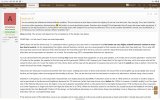Sokel
Master Contributor
- Joined
- Sep 8, 2021
- Messages
- 7,499
- Likes
- 7,761
Agreed and more so if you're like me with classical which is even harder to reproduce.The only real alternative is to give up everything, amps, speakers, players, etc. and go to the event in person.
When you can you go…..but…..Unfortunately, Dire Straits no longer play live with the band we all knew 40 years ago, nor does Dave Brubeck. So we have to settle for something already recorded.
And this essentially becomes our “event”, even if it is only a "false" of it…
Of course we can have both,of course we can mess and tinker with them but I always keep in mind that is just a little better than a child's play and at times and conditions can pass the feeling and makes us happy,sad,etc.
It's ok as long as it's fun.After that...



